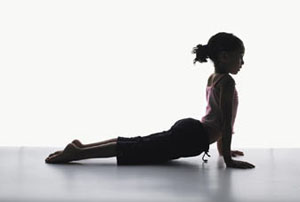By aiding in stress reduction, reducing anxiety, increasing body awareness, strength, and flexibility and increasing self-regulation. Persons with Autism may particularly benefit from yoga in that heightened anxiety, poor motor coordination and strength and weak self-regulation are three areas in which most persons with autistic spectrum disorders struggle and for which there are few other solutions. Yoga poses and breathing techniques could prove to be very helpful interventions for increasing the quality of life for children and adolescents with ASDs. By practicing a simple warm up, strengthening, calming, and tension-releasing exercises that are suitable for reducing coping mechanisms such as hand-flapping, and increasing muscle tone, muscle strength and body awareness. They also offer a range of short and long sequences that can be tailored to fit the needs of the individual child.
 “I have a grandson with Asperger Syndrome who has been doing yoga for about a year. He does especially well with a modified Tree Pose and the modified Spinal Twist. Both poses are relaxing and keep his arms occupied. The Tree is wonderful for strengthening his muscles and helping his balance. The Spinal Twist is a very gentle twist that is good for his upper torso. These yoga poses have helped him release energy in a positive way.”
“I have a grandson with Asperger Syndrome who has been doing yoga for about a year. He does especially well with a modified Tree Pose and the modified Spinal Twist. Both poses are relaxing and keep his arms occupied. The Tree is wonderful for strengthening his muscles and helping his balance. The Spinal Twist is a very gentle twist that is good for his upper torso. These yoga poses have helped him release energy in a positive way.”
Judy Waldman, Former Primary School Teacher
The incidence of diagnosed autism has risen sharply over the past 20 years; some estimates put the rate as high as one in 500 children. Yet I have found very few articles based on yogic training and autistic children. One program in Seattle maintained positive results with a yoga-based treatment called Integrated Movement Therapy; the children reportedly improved their balance and sociability as well as their communication.
Does anyone know anybody who has worked with yoga and autism? Or has anyone got any reading recommendations?








